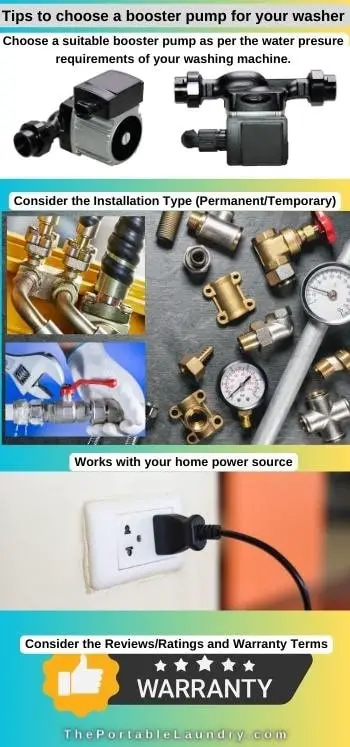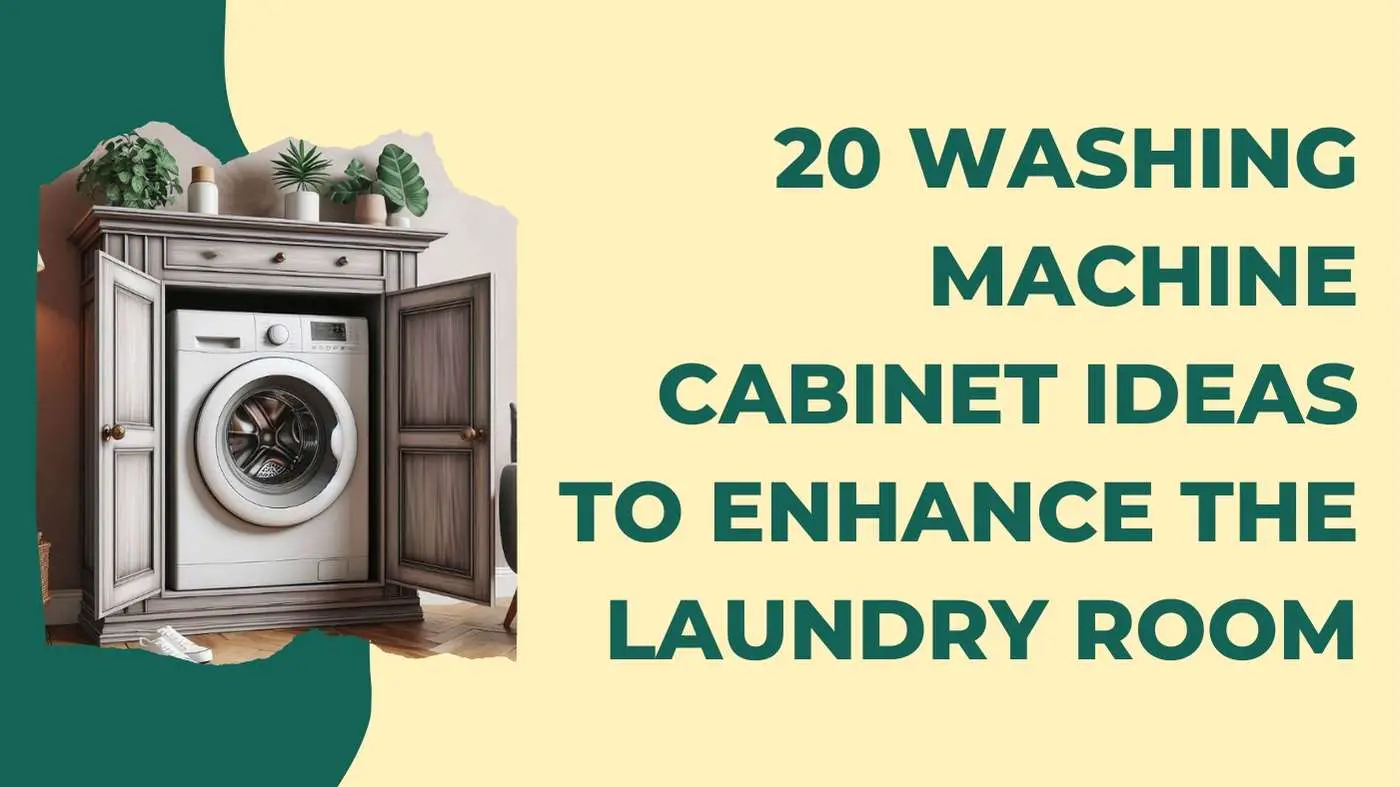Is your Laundry room struggling with low water pressure levels?
If yes, then installing a booster pump becomes a must.
It ensures that your washer runs efficiently without struggling to fill and drain.
A Water Booster Pump is a small, electrically powered pump that helps to increase the water pressure. It helps to improve the performance of your washing machine.
Let us take a quick look at, what water booster pumps are, how they work, and whether they are worth the investment.
Table of Contents
What is a water booster pump for a washer?
A water booster pump is an electrical device that uses a motor to increase the water pressure.
It is responsible for pumping water into the washer during the wash cycle.
You can mount a booster pump near the washer, household main supply, or near the water tank.
It needs the power to run and when the washer is turned on, it pumps the water into the washer until it reaches the desired level.
What are the advantages of a booster pump?
There are many advantages of installing a water booster pump.
Here are some well-known advantages.
- The adequate water pressure can help to fill the washtub. This helps to remove tough stains from your clothing in an effective manner.
- Booster pumps can also help to reduce the amount of time it takes to wash a load of laundry.
- It eliminates the error codes displayed by the washer due to low water pressure.
- They can improve the overall efficiency of your washing machine.
If you are looking for ideas to improve your washer’s performance during low pressures then simply install a mini-booster pump.
Understanding the Science and Impact of Water Booster Pumps on Washing Machine Performance
How Water Booster Pumps Work?
Water booster pumps operate on a simple yet ingenious principle, leveraging fluid dynamics and motorized mechanics to enhance water pressure.
When your washing machine’s water supply faces inadequate pressure, the booster pump steps in to increase the force with which water flows into the machine.
Fluid Dynamics and Pressure Enhancement
The booster pump employs a motor-driven impeller, a rotating blade-like component.
As water enters the pump, the impeller’s rotation creates centrifugal force, pressurizing the water.
This pressurized water is then delivered to the washing machine at a higher force, compensating for low incoming pressure.
Water pressure pumps impact on Washing Machine Performance
- Optimal Water Utilization: Booster pumps ensure that your washing machine receives the required water volume at the right pressure, enabling more efficient cleaning, rinsing, and spinning cycles.
- Enhanced Agitation: Adequate water pressure facilitates the even distribution of detergent and efficient agitation, resulting in more thorough and effective cleaning of clothes.
- Consistent Cycle Times: With a stable water supply, washing machine cycles remain consistent in duration, avoiding interruptions due to water-related errors.
- Gentler on Clothes: Balanced water pressure minimizes fabric wear and tear, preserving the quality and lifespan of your garments.
- Reduced Energy Consumption: Booster pumps contribute to shorter cycle times, potentially leading to energy savings over time.
Potential Challenges and Drawbacks
- Compatibility Issues: Booster pumps may not be universally compatible with all washing machine models. Certain machines might require specific pressure levels or fittings that standard booster pumps cannot provide.
- Installation Complexities: Depending on your choice between temporary and permanent installation, plumbing work might be required. Permanent setups involve more intricate installation procedures.
- Maintenance Demands: While booster pumps enhance performance, they introduce an additional maintenance component. Regular inspections and potential repairs are necessary to ensure the pump’s longevity.
- Noise and Vibration: Some booster pumps can generate noise and vibrations during operation, which might be undesirable, especially if your laundry area is near living spaces.
- Cost Considerations: Booster pumps entail initial investment costs, including the pump itself and potential installation expenses. While the benefits are notable, these costs should be weighed against your needs and budget.
How do you select a booster pump for your washer?

For a washer that struggles with low water pressure, you may install a booster pump.
There are a few aspects to evaluate in selecting a water booster pump for your washer.
We have listed a few important points below, to help you to choose a suitable pump.
Flow Rate and Acceptable Water Pressure
Select a pump that can produce enough pressure to maintain the efficiency of the washer.
Also, check the flow rate that’s compatible with your washing machine.
Suitable Power Source
You’ll want to select a pump that can either run through electricity or operate using a battery. The batteries used to operate the pumps are chargeable in most cases.
Product Warranty
You will be offered a warranty for around 6 months up to 1 year.
Some manufacturers offer extended warranties on their water booster pumps.
You can contact the manufacturer’s helpline for detailed information.
Installation Type
You will need to determine whether you want a temporary or permanent installation.
- Permanent installation will require some plumbing work, but it will be more durable and long-lasting.
- The temporary installation is less expensive and easier to install, but it will need to be replaced more often.
Considering the above factors you can choose a suitable booster pump for your washer.
How to install a booster pump for your washer?
Water booster pumps can be a prominent addition to your laundry if you have low water pressure.
Installing them is not too complex, but there are a few things you need to keep in mind.
Always look into the user manual instructions before installing a booster pump.
Disconnect the Supplies
Shut off the water supply to your washer and unplug from the power outlet.
Locate the Installation point
You’ll need to choose the right location for your pump.
It should be close to the water source and the washer.
- Cut a hole in the supply pipe at this point so that you can attach the pump.
- And install the check valve and pressure switch. These components will help ensure that your pump doesn’t overwork itself.
- Next, you’ll need to connect the pump to your plumbing system. This can be done with PVC pipes or flexible hoses.
- Connect the booster pump to the power source and turn it on. Finally, you may open the main water supply and let the pump do its job.
With everything in place, your new water booster pump should be up and running in no time. Make sure to check for any leaks after the successful installation.
For any leaks, turn off the power immediately and check the seals connecting the pump.
If you are unsure of the cause then contact a professional for help.
Identifying and Troubleshooting Common Water Booster Pump Issues
Noise and Vibration
Issue: Unusual noise and excessive vibrations during the pump’s operation.
Possible Causes:
- Debris or foreign objects caught in the impeller or pump components.
- Loose mounting or connections.
- Damaged or worn-out bearings.
Troubleshooting:
- Inspect and Clean: Check for debris or objects obstructing the pump’s impeller. Clean the impeller and surrounding components.
- Tighten Connections: Ensure all mounting brackets and connections are securely tightened.
- Check Bearings: If the noise persists, inspect and replace damaged or worn-out bearings.
Leaks
Issue: Water leakage from the pump or its connections.
Possible Causes:
- Improperly sealed connections.
- Damaged or deteriorated seals or gaskets.
- Loose or improperly tightened fittings.
Troubleshooting:
- Inspect Seals and Gaskets: Examine all seals and gaskets for damage or wear. Replace as necessary.
- Reinforce Connections: Tighten all connections and fittings to prevent leaks.
- Use Sealant: If necessary, apply a waterproof sealant to connections to ensure a secure, leak-free fit.
Inconsistent Pressure
Issue: Fluctuating water pressure from the booster pump.
Possible Causes:
- Air trapped in the pump or water lines.
- Clogs or obstructions in the water lines.
- Pump motor or impeller issues affecting consistent pressure.
Troubleshooting:
- Bleed Air: If air is causing pressure fluctuations, bleed air from the pump and water lines following the manufacturer’s instructions.
- Clear Obstructions: Inspect water lines for clogs or obstructions and clear them if necessary.
- Motor and Impeller Check: If inconsistent pressure persists, consult the manufacturer’s manual for guidance on checking the pump’s motor and impeller for issues.
Pump Not Starting
Issue: The booster pump fails to start when the washing machine is turned on.
Possible Causes:
- Power supply issues, such as a tripped circuit breaker or unplugged pump.
- Faulty power switch or wiring.
- Motor or electrical component failure.
Troubleshooting:
- Check Power Supply: Verify that the pump is connected to a functioning power source and that the circuit breaker is not tripped.
- Inspect Wiring: Examine the pump’s wiring for any damage or loose connections. Address any issues found.
- Motor and Electrical Component Check: If the pump still does not start, consult the manufacturer’s manual for instructions on checking the motor and other electrical components.
Reduced Flow Rate
Issue: The pump’s flow rate is lower than expected.
Possible Causes:
- Partially closed water supply valves.
- Sediment buildup or clogs in the pump or water lines.
- Damaged impeller affecting water movement.
Troubleshooting:
- Open Valves: Ensure that water supply valves are fully open to allow maximum water flow.
- Clean Pump and Lines: If sediment buildup or clogs are causing reduced flow, clean the pump’s components and water lines thoroughly.
- Inspect Impeller: Check the impeller for damage or wear that might be impeding water movement. Replace if necessary.
How do you maintain a booster pump?
If you have installed a water booster pump, then it becomes important to keep them in good shape.
You should regularly inspect the intake screen for clogs and clean them as needed.
It can be done using a brush or by placing them under running water.
Make sure to keep an eye on the pipes/hoses that connect to the water booster pump.
These hoses can wear out over time, so if you notice any leaks or cracks, be sure to substitute them instantly.
If your pump starts making noise or vibrating unduly, it may be because there’s something caught in it. If that’s the case either clean the pump yourself OR take help from a professional.
Also Read: How to Clean a Portable Washing Machine?
Final Thoughts
If you have a washing machine with a low water pressure supply, then you may consider investing in a water booster pump.
You can install it near your washer, water tank, or close to the main supplies.
A booster pump can be operated manually or automatically.
They can significantly increase the amount of water flow to your washing machine, making it much more efficient.
There are a few different types of water booster pumps on the market, so be sure to do your research before purchasing one.
If your washing machine is not drawing water, then it is likely that the booster pump is not working properly.
In most cases, you will need to replace the booster pump if it stops working.
Frequently Asked Questions
Here are some common questions related to water booster pumps for washers.
Is there a washer that works with low water pressure?
Yes, there are washers that work with low water pressure levels. Brands such as Whirlpool with ZPF technology and Haier with NZP mechanism are known to function even with the lowest water pressure levels.
How much does a booster pump cost?
The cost may vary depending on the capacity selected. There are mini-booster pumps available for a single supply line. You may buy one for your washer and they are quite reasonable for your pockets.
Is it necessary to install a booster pump for the washer?
It is not necessary to install a booster pump if your laundry gets adequate water pressure.
What else can I do to increase the water pressure in my laundry?
Inspect and keep the supply lines clean from clogs and debris. Set up your washer close to the water tank or vice versa. Do not plumb complex supplies towards the water source.
Does the water booster pump impact my energy bills?
The water booster pumps usually function automatically when your washer needs a water supply. Hence it uses significantly less energy. There should not be any major impact on your energy bill as it booster pump actually reduces the wash time.
What are some common problems I might encounter during booster pump installation?
Common issues during installation can include leaks, electrical problems, or compatibility issues with specific washing machine models. If you experience leaks, check the seals and connections. For electrical problems, ensure proper wiring and connections. Compatibility issues may require consulting the manufacturer or seeking professional advice.
How can I ensure the longevity of my water booster pump?
Regular maintenance is key. Clean the pump and its components periodically, checking for clogs or debris. Replace filters as recommended by the manufacturer. If you’re unsure about maintenance, it’s best to consult the user manual or a professional.
What should I do in case of an emergency, like a sudden pump failure or water leakage?
In the event of an emergency, such as a pump failure or severe water leakage, turn off the power to the pump and shut off the water supply immediately to prevent further damage. You can also contact a professional for assistance in case of pump failure.
Are there any legal requirements or building codes I should be aware of when installing a booster pump?
Depending on your location and the type of booster pump, there might be legal requirements or building codes to adhere to. Check with local authorities, and ensure you have any necessary permits or inspections in place.
What if I have specific questions or need further assistance with my booster pump?
If you have specific questions or need additional help, feel free to reach out to our support team or the manufacturer’s customer service. We’re here to assist you and ensure a successful installation and maintenance experience.
You May Also Like
- What is a Washing Machine Standpipe? (Explained)
- What is Extra Rinse in Washing Machine?
- What is a Smart Washer and Dryer? (Explained)
- What is an Agitator in Washing Machine?
- What is a Lint Filter in Washer? (10 Things you must know)
- What is Soil Level in Washing Machine?
- What Is RPM in Washing Machine? (13 Things to know)
- What Is Rinse And Spin In LG Washing Machine?
- What is IE Error in LG Washing Machine? (And Solutions)





